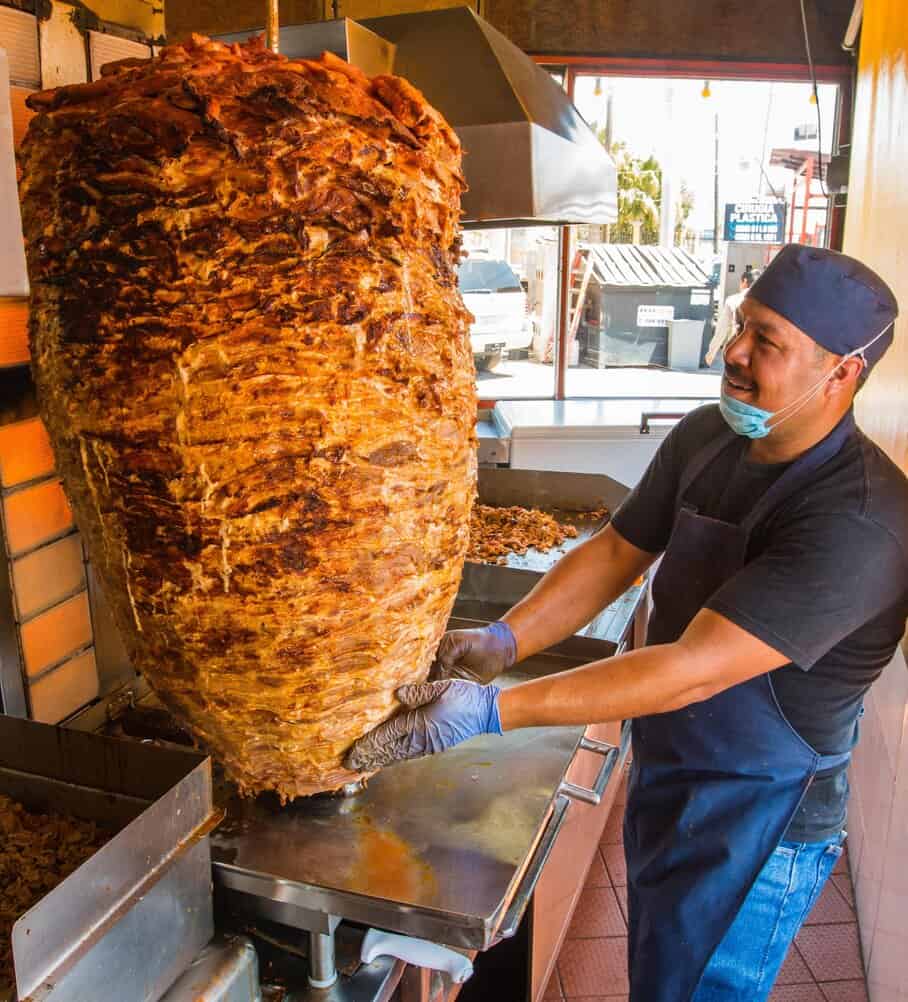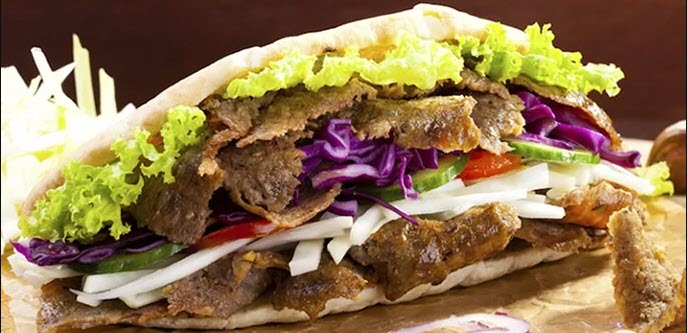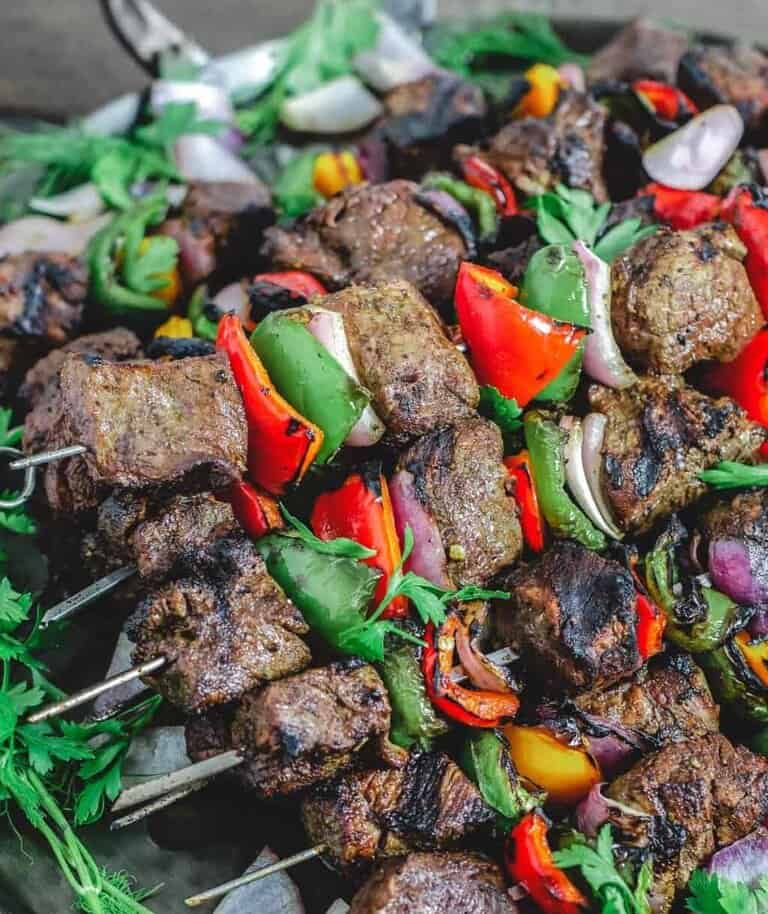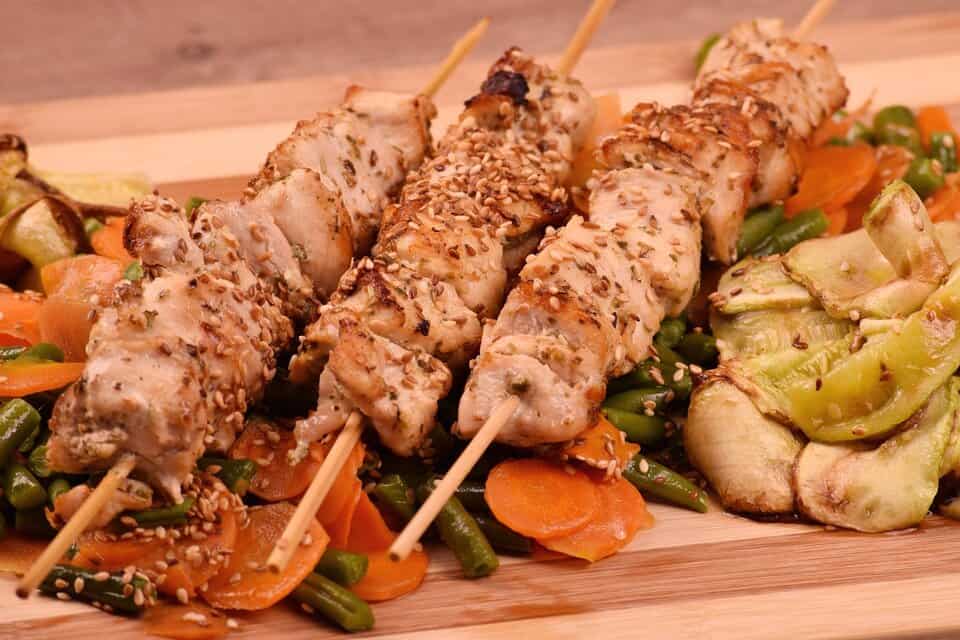Who doesn’t like a good kebab? And if one habit remains true, it’s that we all want to figure out a way to justify the foods we loved being healthy enough – even if not the best choice, when trying to eat healthy. So can this be done with kebabs, or is kebab meat simply too unhealthy to see as anything but the very occasional guilty pleasure? That’s what we’re going to look at today because it’s an important topic – and not everyone’s going to be happy with the results.
Kebab meat, particularly the popular doner kebab variety, has long been the subject of debate when arguing on whether or not its healthy, unhealthy, or somewhere in between. After all, people looking for food to bulk up on have different food/health needs than dieters looking to shed some weight. Kebabs have often been touted as healthy because of their common origins in traditional Mediterranean cuisine, but does that hold up?
After all, not all kebabs and not all kebab meat consists of roast lamb and spices, often accompanied by rice and salad the way the meat and meal was traditionally served in Greek and Turkish influenced areas. However, modern variations, such as the doner kebab served in pita bread with various dressings, add in a lot of fat, calories, and preservatives that aren’t in the more traditional preparation and that can change more than just the taste but also the diet impact.
While kebab meat can be a good source of protein, vitamins, and minerals, the overall healthiness of a kebab depends on a number of factors, including the type of meat used, cooking methods, and accompanying ingredients.
Generally speaking kebabs are not considered health food in most modern forms, though they still have some positive benefits like high protein and great combination of fat and carbs for energy.
Preparation and additives matter a lot in answering the question of whether or not kebabs are healthy. For example, grilled lean meat, wholemeal pita, and salad can be healthier choices, but dressings high in fat or trans fat content can diminish the dish’s nutritional benefits. Keep this in mind when making food choices about how kebabs fit into your overall eating plan.

Types of Kebab Meat
The exact make up of kebab meat will vary greatly on the type of kebab. Some use a sausage that is a blend of fat and sometimes multiple types of meat while kebabs that are more skewer based are often chunks of chicken, fish, lamb, pork, or beef depending on the protein of choice that the kebab maker wants to use.
For Doner kebabs or more traditional kebabs the meat of choice is mutton or lamb. While these are a great option it is worth noting that in many places in Europe that did lab tests and surprise inspections, the kebab sausages being used were often majority beef, but also had cheaper proteins like chicken, beef, or even pork mixed in. Considering the various religious beliefs on eating beef or pork, that’s not a great find.
Even worse for a few was the discovery of dairy in kebabs, which can lead to severe allergies and should never be found in a put together kebab.
Doner Kebab Meat
Doner kebab meat is a popular choice in many countries and it’s undeniable that if you’re looking for a great quick hot meal or the perfect after pub crawl bit of food then it’s hard to argue with what Doner Kebabs bring to the table. The problem is the meat in modern Doner kebabs are not what you would see from a traditional kebab a few centuries ago.
The ever-popular Doner kebab is made up of thinly sliced meat, primarily processed from lamb, beef, veal, or chicken, but not pork source. The meat is marinated in various spices and then cooked on a rotating spit, giving it a unique flavor profile.

Shish Kebab Meat
Shish kebab, another common type of kebab, typically consists of bite-sized cubes of meat like beef, lamb, fish, or poultry. According to The Spruce, The best cut of beef for shish kebabs is filet mignon, while other great alternatives include Porterhouse and rib-eye. Marinating the steak is extremely important as adding extra flavors and when done properly can make a slightly inferior piece of meat moist, juicy, and tasty, punching up in taste compared to what you expected from that level of quality.
Popular mixtures for shish kebabs are olive oil, lemon juice, and an array of spices such as garlic, smoked paprika, oregano, and in some cases hot peppers. Shish kebabs tend to be a bit healthier since they are skewer based, eliminating the use of sausage which tends to be fattier with more calories, and eliminating the extra fat and calories that can come from dressings and pita bread.

Chicken Kebab Meat
Chicken kebabs are a popular low-fat option, with 100 grams of chicken kebab meat containing around 151 calories, and approximately 20% of those calories coming from fat. There’s a reason that skinless chicken is a popular choice among body builders, gym rats, and those looking to make healthy food choices. It’s a protein that is relatively low in calories, very high in protein, and relatively low in fat.
That’s a great combination, and a sprinkle of garlic, a drizzle of olive oil, and a layer of sesame seeds can be a healthy garnish to bring the taste of a chicken kebab fully home. It’s also safe to assume that on a chicken skewer kebab, it’s 100% chicken meat.
Besides chicken, there are various other meats available for creating kebabs, such as:
- Lamb: Often found in kebabs like New Zealand lamb shoulder steak, having around 10-15% fat content source.
- Fish: Fish kebabs can be made using hearty varieties like salmon, shrimp, or tuna.
- Turkey: Turkey kebabs are an alternative for those looking for a leaner option in comparison to red meat.
- Veal and mutton: Less common in traditional kebabs but still used in some regional variations.
- Bison: Very rare and definitely not a traditional meat, but incredibly healthy and worth the price if you ever have a chance to have the experience of trying this out.
Although the healthiness of kebab meat depends on the type and cut of meat as well as the preparation method, it can be said that kebabs are generally a healthier fast-food option when compared to deep-fried alternatives.

Health Concerns and Benefits
There are some great health benefits to all kebabs, with some having more than others, but it’s important to understand both the pros and cons of any potential meal that involves kebab meat.
Weight Loss and High-Protein Diet
Kebabs can be a healthier fast food option as they are not deep-fried and include bread and salad. The meat used in kebabs, usually lamb or chicken, is a high-protein source, which can be beneficial for those trying to maintain or lose weight. Protein helps to build and repair body tissues, and also increases feelings of fullness, which may assist in weight loss by reducing overall calorie consumption.
There are also many many studies showing that protein burns more of its own calories off in digestion, making it a favorite with the weight loss crowd.
Processed Meat and Cancer Risk
There is a growing concern that excessive consumption of processed meats, such as sausages, bacon, and some types of kebab meat, may have negative health consequences.
A number of studies have found links between processed meat and various forms of cancer, as well as heart disease and diabetes. Experts suggest that consuming too much processed meat can be detrimental to one’s health. However, not all kebab meats are processed or pose the same cancer risk.
Fat Content
The fat content of kebab meat can vary depending on the type and quality of meat used. Generally, kebab meats made from New Zealand lamb shoulder steak contain around 10-15% fat, while other types, such as doner kebabs, have been found to be high in fat, sometimes containing twice the maximum daily allowance for women. It is important to choose kebabs with lower fat content and consume them in moderation to maintain a well-balanced diet.
Heart Disease and Cholesterol
Some kebabs may have a high trans fat content, which raises cholesterol levels and increases the risk of heart disease. A report found that 60% of doner kebabs tested were high in trans fat. Red meat has also been associated with increased risk of heart disease and some forms of cancer.
By choosing kebabs made from leaner meats like chicken or fish, consumers can reduce their intake of unhealthy fats and lower their risk of developing heart-related health issues.
Alternative Protein Sources
If you’re willing to look at some less traditional or non-traditional kebabs, there are plenty of alternative protein options that are worth considering. These options won’t be for everyone, but it just show that whether in kebab form or non-kebab form, there are options available.
Vegetarian and Vegan Options
Beans and lentils are a fantastic source of protein for vegetarians or vegans. They can be easily incorporated into kebab recipes, providing excellent nutritional value. A combination of beans or lentils with vegetables, such as mushrooms or bell peppers, can make a delicious and healthy kebab option.
Tofu is another great option for vegetarian or vegan kebabs. Being an excellent source of protein, tofu can be marinated and grilled to perfection, providing a satisfying and healthy alternative to traditional meat kebabs. Moreover, soya protein can help lower cholesterol levels, making it an even healthier choice.
Nuts and seeds can also be added to kebab recipes, providing additional protein and essential nutrients. Examples include:
- Almonds
- Walnuts
- Pumpkin seeds
- Sunflower seeds
Lean Meat Options
For those who prefer meat-based kebabs, opting for lean meat options can be a healthier choice. Bison, for instance, has 17 grams of super lean protein in a 4-ounce serving. This lean meat is packed with B-vitamins, zinc, selenium, and iron, providing a nutritious alternative to traditional kebab meats.
Ground beef, when chosen carefully with lower fat content, can also be used to create healthier kebabs. Opt for lean or extra lean ground beef, which contains less saturated fat, and can be seasoned and grilled to create a delicious and satisfying meal.
Incorporating these alternative protein sources into kebab recipes can make for healthier meal options, while still satisfying the craving for a tasty, grilled skewer.
Kebab Preparation Methods
Kebab preparation methods might contribute to the overall nutritional value and healthiness of the dish. This section will discuss Grilling and Cooking Oils, as well as Traditional Middle Eastern and European Recipes.
Grilling and Cooking Oils
The healthiness of a kebab often depends on the cooking method used. Grilling is a popular method for preparing kebabs. It involves placing marinated and skewered meat and vegetables on a grill, allowing for excess fat to drip away as the food cooks. This results in a lower fat content compared to deep frying or pan frying methods. Cooking oils, such as olive or canola oil, can be used to coat the kebab and grill, providing additional flavor and moisture while ensuring the food doesn’t stick. Opting for healthier cooking oils that are low in saturated fats can also contribute to a more nutritious kebab.
Traditional Middle Eastern and European Recipes
Middle Eastern Recipes
Traditional Middle Eastern kebab recipes often utilize a blend of spices, such as cumin and garlic, which not only add flavor but also offer potential health benefits. The marinade usually includes yogurt, which can help tenderize the meat while adding a tangy flavor. Onions and salad are often served with the kebab, providing essential vitamins and minerals.
Moreover, bread is an important component of Middle Eastern kebab dishes, typically comprising of flatbreads like pita or lavash. The bread can be used to wrap the grilled kebab or simply served alongside it, adding carbohydrates and fiber to the meal.
European Recipes
In European kebab recipes, the meat is often marinated in a blend of spices similar to those used in Middle Eastern dishes. However, the marinated meat is commonly cooked on a large rotisserie, known as a doner kebab in some regions. The thinly sliced meat is then served in bread with toppings like onions, salad, and sauces. Although European kebabs can be high in sodium due to the seasoning and sauces, opting for a whole grain bread and limiting high-sodium sauces can help make this dish healthier.
In conclusion, the healthiness of kebab dishes largely depends on the preparation methods and ingredients used. Grilling and using healthier cooking oils, as well as opting for whole-grain bread and a variety of vegetables, can contribute to a more nutritious kebab experience.
Serving and Pairing Suggestions
When enjoying kebab meat, there are several serving and pairing suggestions to help turn it into a healthier meal. The right choice of side dishes and some simple modifications can make a big difference in the overall nutritional value of the meal.
Healthy Swaps
To make a kebab meal healthier, consider swapping out certain components for more nutritious options:
- Instead of white rice, serve kebabs with pesto rice or lemon rice, made with whole grains.
- Replace deep-fried chips with oven-baked sweet potato fries or roasted vegetables like broccoli, cauliflower, or bell peppers.
- Opt for leaner types of meat like chicken breast or shish kebab instead of doner kebab, which is higher in fat, salt, and sugar.
- Incorporate avocado and other healthy fat sources, like olive oil, in salads or as toppings to boost the meal’s nutritional content.
- When looking for a tasty but nutritious side dish, consider curried tomatoes and chickpeas, which are packed with nutrients and pair well with the flavors in kebab meat.
Modifications
Making small modifications to traditional kebab recipes can also help improve their healthiness:
- Cook kebabs with extra vegetables, such as onions, tomatoes, and bell peppers, to increase the meal’s fiber and nutrient content.
- Use smaller portions of meat or switch to a leaner cut like chicken breast or shish kebab, which have lower fat content.
- Incorporate eggs, beans, or other plant-based protein sources to create a more balanced meal.
- To add flavor without adding excess salt or fat, use spices, herbs, and chili to season the kebab meat.
- For a lighter dipping sauce, explore options like Greek yogurt-based tzatziki or a tomato-based salsa.
As you can see, a little bit of creativity goes a really long way! By implementing these healthy swaps and modifications, it’s possible to create delicious and wholesome kebab meals that give the best healthy options while still delivering a full belly after a great meal.
Other Kebab Articles You May Enjoy
